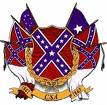From The Palmetto Republic:
The Palmetto – South Carolina’s Liberty Tree
On May 29, 2010, In SC, Secession, By Palmetto Patriot.South Carolina’s beautiful State tree and most famous symbol is the Palmetto tree, of course. Most South Carolinian school children could probably tell any new-comer or visitor of how the Colonial patriots in the Palmetto tree fort on Sullivan’s Island defeated the British imperial navy during the Revolutionary War.
In Charleston, John Rutledge, a member of the Continental Congress, arrived in Charleston with information of a British move into South Carolina. Named as the newly appointed president of the General Assembly that remained as the backbone of South Carolina’s revolutionary government, Rutledge organized a defense force under the command of 46-year-old Colonel William Moultrie, a former militiman and Indian fighter. Moultrie saw Sullivan’s Island, at the mouth of the entrance to Charleston Harbor as a good place suited to build a fort to protect the entrance from intruding enemy warships…. Moultrie and his 2nd South Carolina Regiment arrived on the island in March, 1776 and began construction of a fortress to defend the island and channel to Charleston Harbor…. The square-shaped Fort Sullivan made up of only the completed seaward wall, with walls made from Palmetto logs 16 feed wide and filled with sand, which rose 10 feed above the wooden platforms for the artillery.
The original blue SC flag with the white crescent was amended nearly a century after the Revolutionary War when our State seceded from the United States. “The palmetto tree was added in 1861 to honor Moultrie’s heroic defense of the palmetto log fort on Sullivan’s Island against the attack of the British fleet on June 28, 1776.” The Great Seal of South Carolina also bears the Palmetto tree.
Our famous Palmetto tree is paralleled in some ways by the Liberty Tree tradition that arose during the struggle against the British in the 1770’s. And just as our own symbol eventually found its way on the State banner, so too was the Liberty Tree commonly found upon flags from the Revolutionary War period in support of American independence.
“[The Liberty Tree] was a famous elm tree that stood in Boston, near Boston Common, in the days before the American Revolution. The tree was a rallying point for the growing resistance to the rule of Britain over the American colonies. In the years that followed, almost every American town had its own Liberty Tree—a living symbol of popular support for individual liberty and resistance to tyranny….”
The revolutionary group the Sons of Liberty, who were barred from public assembly, would meet informally under the famed elm tree in South Boston. To protest the much-maligned Stamp Act of 1765, members of the group hung effigies of British tax collectors off the branches of that elm.
The Palmetto flag is one of the best known and most loved symbols in all of North America. It can be found on license plates, belt buckles, t-shirts, blankets, flip-flops, hats and anything else you can imagine. Perhaps excluding Texas, we have the most recognisable and beloved symbol of any State – a symbol which unites South Carolinians. And just as the Palmetto was the primary symbol for pro-liberty resistance in two revolutions against centralised, outside rule, so shall it be again in our effort for a free Third Palmetto Republic.




No comments:
Post a Comment
Note: Only a member of this blog may post a comment.